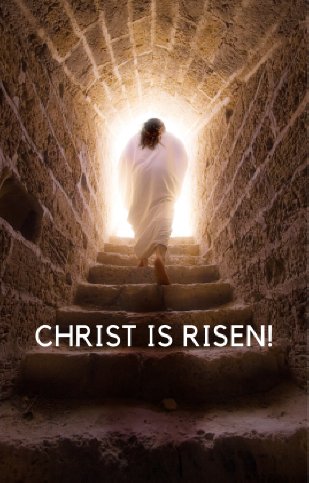Five Easter Symbols
What Do They Mean?
Materials: cut and mount on colored paper, pictures of the following objects. (Better yet, have the actual objects for the lesson.)
Children dressed in new clothes or a dressed doll, baby animals and a bunny, eggs, Easter lily, Three crosses and a picture of an empty tomb, Jesus picture pasted on to a large red heart.
1. New Clothes: Luke 20:1-17
It was the custom among many early Christians to have newly baptized Christians wear new white clothes for the Easter celebration. Like many other Easter symbols, the new clothes represent new life offered through the death and resurrection of Jesus.
Later, it became the custom in many European towns and villages for people to put on new clothes and parade through town. The lead person would hold a cross or candle. In New York City, this became the annual Easter Parade down Fifth Avenue to show off new clothes following the Easter services.
Jesus came out of the tomb with a new body. God will give us new bodies in the resurrection. God dresses up the earth in the Spring with new flowers, grasses and budding trees. LIFE WINS!
2. Baby Animals/Easter bunny: II Corinthians 5:17
Spring is the time for newly born animals. We become new creations when we accept Jesus. While the early Christians celebrated Easter, others were celebrating springtime. After a cold, dark winter, the people were glad to see new leaves and flowers and animals have babies--kittens and chicks and, yes, baby bunnies. There is an old story from Germany about a poor woman who had colored eggs to show new colors of spring. She put them around in her yard for the children to find. She put some eggs in an old nest. The children saw a rabbit sitting on the nest and when he heard their noise, he leaped away. We all know how children's imagination works--rabbits bringing Easter eggs made a great story! So it began. The Easter Bunny has nothing to do with the REAL Easter, but he is a part of celebrating spring and spring is nature coming back to life again. It is a picture of Jesus rising from the dead.
3. Easter Eggs: Matthew 26:1-6
An egg is a perfect symbol for Easter. When an egg hatches, it seems like new creation comes from a dead object. This reminds us of Jesus' resurrection. It is said that the early church would greet one another by tapping eggs. The first would say, "Christ is risen!" The other person would reply, "He is risen indeed!"
4. Spring Flowers/Easter lily: John 11:25-26 Matthew 6:28-30
The white Easter lily stands for purity. Artists for centuries have painted Lilies in religious pictures. It is said that lilies grew in the garden where Jesus prayed the night before He died and also in the garden where He was buried. Lilies are mentioned in the Bible. In Matthew 6:28-30, they are given as a symbol of trust. Jesus is referred to as the "Lily of the Valley."
5. Cross and Empty tomb: John 20:1-8, Revelation 3:20
This is the REAL EASTER: an empty cross and an empty tomb. Easter is the oldest Christian festival. To the early church, Jesus rising from the dead was so important, it was a weekly celebration. Every Sunday was Easter! And that is why many Christians now worship on Sundays. We also make a very special day in spring a special Easter Sunday.
(Show heart with Jesus picture.)
Today we remember Jesus' love for us. He died and came alive again.
(To close the lesson, give students a candy-filled plastic egg and then have them say the early church greeting.)
LEADER: Christ is Risen!
STUDENTS: He is risen indeed!
Copyright 2013 Frances Kemp
Don't miss our Easter
Activities!

Return to the Lessons and Sermons page.
You can make a
difference!
Your purchases
and donations to the site help to distribute
our children's ministry resources to churches across the world.
Subscribe to our Newsletter - Learn More